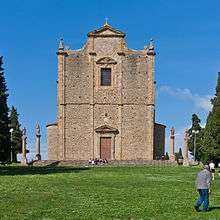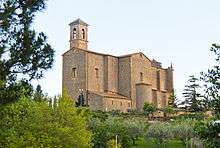San Giusto, Volterra
| San Giusto, Volterra | |
|---|---|
 | |
| Basic information | |
| Location | Volterra, Italy |
| Affiliation | Roman Catholic |
| Province | Pisa |
| Year consecrated | 1775 |
| Architectural description | |
| Architect(s) | Giovanni Coccapani (design) and Ludovico Incontri (completion) |
| Architectural type | Church |
| Architectural style | Renaissance |
| Groundbreaking | 1628 |
Santi Giusto e Clemente is an ancient church in Volterra, Italy. It is also known as San Giusto or San Giusto Nuovo.
History
An ancient church on the site, built at least by the 7th century, was called San Giusto in Botro, built over the tombs of Saints Giusto and Clemente. Construction of the present stone church was begun on October 28, 1628, based on designs by the architect Giovanni Coccapani, which were carried out by his pupil Ludovico Incontri. The new church was consecrated in 1775.

Gated inside the choir, the church contains an ancient altar, inscribed with the names of Cunincpert, 7th-century king of the Lombards, and the steward of the bishop Gaudenziano Alchis, founder of the first temple dedicated to St Giusto. Placed in an urn on the altar are the relics of St Crescenzio, with 17th-century statues by Francesco Franchi. An oratory chapel houses a canvas paining of Elijah asleep (1631) by Baldassarre Franceschini and the church has altarpieces of St Francis Xavier preaches in India (1743) by Giovanni Domenico Ferretti and a Visitation by Cosimo Daddi. The painting of the Madonna delle Grazie (1451), by Neri di Bicci, is now in the Diocesan Museum of Sacred Art in Volterra. That polyptych stood originally in the church of San Giusto in "Botro".[1]
References
| Wikimedia Commons has media related to Santi Giusti e Clemente (Volterra). |
- ↑ Comune of Volterra; chiese.
Coordinates: 43°24′39″N 10°51′02″E / 43.41083°N 10.85056°E